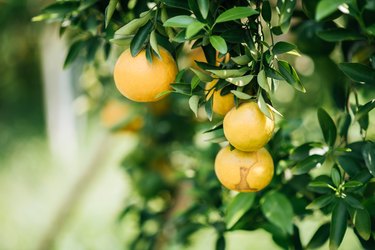
Citrus trees thrive in the subtropical and tropical climates of U.S. Department of Agriculture plant hardiness zones 9 through 11. Watering citrus trees in Phoenix, the Southwest and other desert and subtropical regions varies according to the citrus species, the size of the tree, whether it is planted in the ground or in pots and local weather conditions.
While citrus trees grow well in the frost-free, low desert areas of Arizona, they require more water than native trees and plants. Monitor your citrus for signs of drought stress and deep water as needed to keep your trees healthy. Citrus water needs vary depending on the time of year as well as the age and size of the tree. In general, water every seven to 30 days when the soil is dry to a depth of 6 inches.
Video of the Day
Video of the Day
About Citrus Trees
Native to southern Asia, the original citrus trees – citrons, mandarins and pomelos – and their hybrids had spread to Italy by approximately 300 B.C. The Mediterranean climate of Italy and North America's Southwest suits citrus trees, though they require supplemental water during the dry summer season.
Today, there are a multitude of citrus species and hybrids available to the home gardener, including sweet navel oranges, Meyer lemons, grapefruit and mandarin hybrids known as tangelos and kumquats. Citrus trees can be found in standard, semidwarf and dwarf sizes, with grapefruit trees growing up to 40 feet tall and wide and orange trees reaching 25 feet tall and wide. Generally, semidwarf and dwarf trees are better suited to home gardens and, being smaller, require less water to produce their tasty fruits.
Citrus Trees in the Landscape
Citrus trees planted in the landscape vary in their water needs depending on the soil type, season and time of year. A citrus tree with a canopy of 10 feet in diameter requires an average of 1.9 gallons of water per day in winter and 15.1 gallons per day during the hottest part of summer, while a full-size tree with a 24-foot-wide canopy requires 10.8 gallons in winter and 86.7 gallons in summer. However, citrus trees shouldn't be watered daily. Space waterings between seven and 30 days apart depending on the weather and moisture level of the soil.
A home orchard may be watered using drip irrigation. Citrus trees also tolerate basin or flood watering; simply build a 4- to 8-inch-tall basin around the tree that extends just past the canopy drip line. Fill the basin with water and allow it to soak at least 2 feet into the soil. Wait until the soil is dry to a depth of 6 inches before watering again.
Young citrus trees require watering every two to three days after planting, slowly reducing after the first month to every three to five days. By the time a tree is more than three years old, water every two weeks in summer and every three to four weeks in winter.
Citrus Planted in Pots
Citrus trees planted in containers require more frequent watering in summer, as the soil dries out quickly on hot days. Check the soil moisture daily and when it is dry to a depth of 2 to 3 inches, add water until it runs from the bottom of the pot. Never allow a potted citrus to completely dry out.
Signs of Underwatering Citrus Trees
Overwatering and underwatering citrus trees can permanently damage and possibly kill the tree. Signs of underwatering citrus trees and drought stress begin with the normally glossy green leaves becoming dull and curling. If the tree isn't watered, the leaves dry out and, starting at the tip, turn brown and crispy until they drop from the tree. The flowers and fruit will soon follow.
While summer heat dries the soil quickly, use caution during the rainy season. Citrus should be planted in well-drained soils or on a south-facing hillside, which provides both sun and good drainage. Wet soil and yellow curled leaves indicate overwatering, possible fungal infections and root rot.